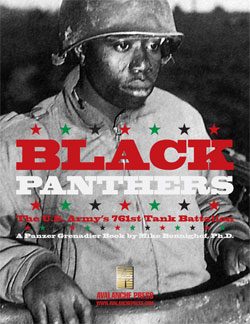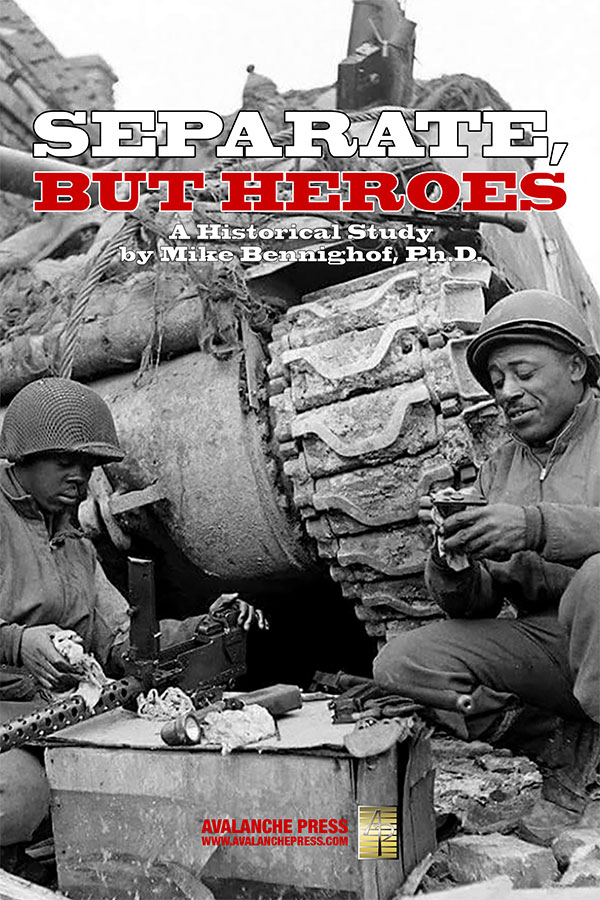| Race in America:
The Black Doughboys, Part One
By Mike Bennighof, Ph.D.
January 2025
 It seems to me that a story without a message, however subliminal, is like a man without a soul. It seems to me that a story without a message, however subliminal, is like a man without a soul.
- Stan Lee
As war engulfed Europe and spread around the globe, the United States Congress passed the National Defense Act in May 1916 to expand the Regular Army to 165,000 men and the National Guard to 450,000. A year later, the Army numbered 121,000 and the National Guard 181,000. The United States declared war on Imperial Germany on 2 April 1917, and President Wilson asked for one million volunteers to fight the Germans.
By mid-May, only 73,000 had trickled in to Army recruiting stations, and Congress passed the Selective Service Act of 1917 to introduce conscription. Unlike the Civil War draft, men could not purchase substitutes, and the draft gave no exemption to any racial minorities. American Indians (who would not become U.S. citizens until 1924) had to register, but could choose not to serve. Puerto Ricans were gifted citizenship just in time to be drafted, and were placed in segregated units (with Black Puerto Ricans segregated in their own regiment, the 375th Infantry). Draft boards were instructed to mark the registration forms of Black men, who would then be assigned to segregated units. Most Black recruits went to labor and service units, where they made up about a third of the total strength.
 The Regular Army’s four regiments of Black soldiers did not see action in Europe during the First World War. The 24th Infantry remained on the Mexican border, while the 25th Infantry went to the Philippines along with the 9th Cavalry Regiment. The 10th Cavalry Regiment remained on the border and fought a group of Mexican militiamen in August 1918. The Regular Army’s four regiments of Black soldiers did not see action in Europe during the First World War. The 24th Infantry remained on the Mexican border, while the 25th Infantry went to the Philippines along with the 9th Cavalry Regiment. The 10th Cavalry Regiment remained on the border and fought a group of Mexican militiamen in August 1918.
The Black regiments that would see combat in France were all newly-formed. Mobilization brought the National Guard into federal service, including two Black infantry regiments, the 15th New York and the 8th Illinois. The assorted Black companies and battalions from other states were collected in the 372nd Infantry Regiment. To round out a full division’s worth of Black infantry (American divisions followed the “square” pattern of four regiments during this period), draftees from the Deep South, mostly South Carolina, made up a fourth regiment. Together the four regiments formed the 93rd Infantry Division (Colored), but were kept separate and this “division” never included artillery, machine-gunners or any other subordinate units.

The Harlem Hellfighters in the Meuse-Argonne, September 1918.
America’s new British and French allies saw the pending arrival of fresh American troops as a chance to replenish their own depleted ranks. They pressed Pershing to assign individual regiments or even battalions to British or French divisions, but Black Jack stoutly refused, insisting that the American Expeditionary Force would fight as a unified American army, under American command, or it would not fight at all.
Meanwhile, African-American troops had begun to arrive in France. The 15th New York, formed in 1916, had been scattered across New York State on guard duty after mobilization. In August 1917 its white commander, Col. William Hayward, tried to use his deep connection to New York Gov. Charles Seymour Whitman (Hayward had been his campaign manager and then his counsel) to have the regiment assigned as New York’s contribution to the white 42nd “Rainbow” Infantry Division, a unit made up of Guard formations from across the country as a show of American solidarity, and then to the 27th “Empire” Infantry Division made up of New York regiments. Both efforts failed (though the legend that Hayward was told that “Black is not a color of the rainbow” appears to be a later invention).

Just a few of the Harlem Hellfighters to wear the Croix de Guerre.
In October 1917 the regiment moved to Camp Wadsworth, South Carolina along with two white regiments of the Empire Division. Hayward extracted a solemn oath from his men to not fight with the locals, but the white soldiers of the Empire Division had made no such promise and formed groups to escort the Black troops into nearby Spartanburg. When Black soldiers were assaulted, white New York soldiers promptly beat the hell out of their attackers. In a surprising show of solidarity for the times, the white New York Guardsmen further refused to patronize any Spartanburg business that would not serve their Black comrades.
Fearing a repeat of the Houston Riot of August, Camp Wadsworth’s commander urged the War Department to send the 15th New York to France right away. After just 12 days of training the regiment left South Carolina for Camp Mills on Long Island, where they were bivouacked alongside the 165th Infantry, formerly the 4th Alabama. The Alabama Guardsmen put up “White Only” and “Colored Only” signs, the New York Guardsmen tore them down, and for days the two regiments brawled repeatedly along the street separating their campsites. The New York Irish of the Fighting 69th, whose grandfathers had lynched Black men during the 1863 New York Draft Riots, now gleefully joined in alongside their Black brothers. The melees only stopped when the Black Guardsmen moved to armories and tent camps within the city, and finally in November they sailed for France.
The 15th New York’s arrival coincided with increased pressure on Pershing from his French allies to repay some of the assistance the Americans had received – weapons, instructors, barracks, food – by attaching American troops to their divisions. Pershing yielded and offered the four Colored regiments of the 93rd Infantry Division, which had yet to form any support units.
Col. Jean L.A. Linard, the head of the French military mission to the American Expeditionary Force, passed along a secret memo to the French high command outlining American expectations for French treatment of African-American troops. French officers must not be seen dining with, shaking hands with or otherwise treating African-American officers as though they occupied the same social plane. “We must not commend too highly the black American troops particularly in the presence of white Americans,” he wrote. “It is all right to recognize their good qualities and their services but only in moderate terms strictly in keeping with the truth. . . . White Americans become greatly incensed at any public expression of intimacy between white women with black men.”
The 15th New York, now redesignated the 369th Infantry Regiment, spent several months in training and on labor service laying railroad tracks before it joined the French 16th Infantry Division, later serving with the French 161st Infantry Division. The French issued them Lebel rifles, Adrian helmets and French accoutrements; the men kept their American uniforms and greatcoats (French colonial troops, of whatever racial origin, wore khaki rather than horizon blue, so the African-Americans resembled French Africans at a distance).

The Harlem Hellfighters return to New York. February 1919.
The 369th Infantry entered the front lines in April 1918, and almost immediately German probes tested the new arrivals. A patrol of perhaps three dozen Germans attempted to overrun an observation post manned by Cpl. Henry Johnson and Pvt. Needham Roberts. Roberts was immediately wounded, but Johnson – later named “Black Death” by the Saturday Evening Post – appears to have gone completely berserk, fighting off the Germans with rifle butt, fighting knife, grenades and his bare hands. At 5-foot-4 and weighing 130 pounds, the 26-year-old former railway porter killed four Germans and wounded two dozen more, then carried Roberts to safety despite 21 assorted wounds.
The French Army pinned the Croix de Guerre on both Johnson and Roberts. The U.S. Army initially gave no recognition; when Johnson tossed away his prepared lecture notes during a post-war tour and spoke of the racist abuse heaped on Black soldiers during the war, he was arrested for improperly wearing his uniform. Johnson finally received the Purple Heart in 1932, three years after his death from tuberculosis. In 2003 he received the Distinguished Service Cross, and in 2015 that was upgraded to the Congressional Medal of Honor.
The 369th Infantry quickly gained a reputation among the French Army for its fighting prowess, and fame among the civilian population for its outstanding band. The “Harlem Hellfighters” would see more time in the trenches – 191 days – than any other American regiment. In all, 170 officers and men of the 369th Infantry received the Croix de Guerre, as well as the entire regiment as a unit award. The Harlem Hellfighters were present – still as part of the French 161st Infantry Division – at the Argonne, Belleau Wood and Chateau-Thierry, and were the first American regiment to reach the Rhine River.
The full series is here:
• Race in America: Founded on Slavery
• Race in America: Civil War
• Race in America: Jim Crow
• Race in America: The Black Doughboys, Part One
• Race in America: The Black Doughboys, Part Two
• Race in America: Red Summer
• Race in America: Tulsa
• Race in America: Klan Scam
• Race in America: Strange Fruit
You can order the Black Panthers Historical Study right here.
That’s both history and scenarios.
Please allow an extra six weeks for delivery.
You can order the Separate, But Heroes book right here.
That’s just the exciting history.
Please allow an extra six weeks for delivery.
Sign up for our newsletter right here. Your info will never be sold or transferred; we'll just use it to update you on new games and new offers.
Mike Bennighof is president of Avalanche Press and holds a doctorate in history from Emory University. A Fulbright Scholar and NASA Journalist in Space finalist, he has published an unknowable number of books, games and articles on historical subjects.
He lives in Birmingham, Alabama with his wife, three children and his dog, Leopold.
Want to keep Daily Content free of third-party ads? You can send us some love (and cash) through this link right here. |
